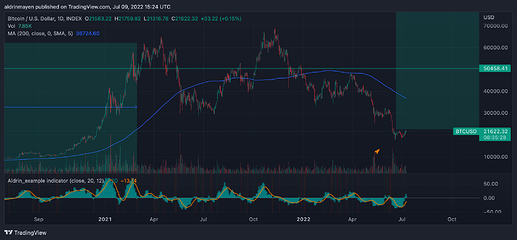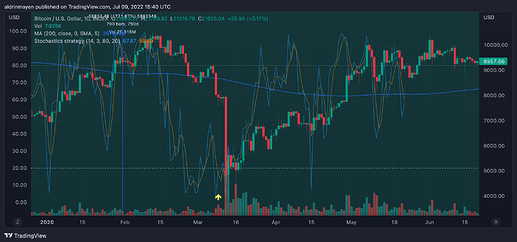- What does the language operator [] do? (Hint: It’s not for regular arrays)
[] whatever is inside the language operator []
{ provides a value || series of values;}
- What does the input function do? (Hint: Try it in Tradingview)
input option provides configuration options in the charts;
oh man! i did my first try but have to add plot() into it to see on trading view what i was doing; i follow guidance from nefty.net
study(title="Aldrin_example indicator" , overlay=false)
//input options
data = input(title="Data", type=source, defval=close)
lookback = input(title="Lookback period", type=integer, defval=20)
lenMA = input(title="Lenght MA", type=integer, defval=12)
// Calculate rate of change and its MA
roc = roc(data, lookback)
rocMA = sma(roc, lenMA)
// Plot values
plot(series=roc, title="RoC", color=teal, style=histogram, linewidth=4)
plot(series=rocMA, title="RoC MA", color=orange, linewidth=2)
3. What does the Strategy function do?
allows to set a buy/sell position of a trade
nefty.net for a sample stragegy
strategy(title="Stochastics strategy", overlay=true, scale=scale.left)
// Inputs
length = input(title="Length", type=integer, defval=14)
dLength = input(title="D Length", type=integer, defval=3)
obLevel = input(title="Overbought", type=integer, defval=80)
osLevel = input(title="Oversold", type=integer, defval=20)
// Compute values
stochK = stoch(close, high, low, length)
stochD = sma(stochK, dLength)
// Plot values
plot(series=stochK, color=#1E90FF, title="K")
plot(series=stochD, color=orange, title="D")
hline(price=obLevel, color=#C0C0C0)
hline(price=osLevel, color=#C0C0C0)
// Submit orders
if (crossunder(stochK, osLevel))
strategy.entry(id="Enter Long", long=true)
if (crossover(stochK, obLevel))
strategy.entry(id="Enter Short", long=false)
4. What information does the Volume variable contain?
it provides the amount of trades done in any given timeframe or series of timeframes
- previous values
2.returns input value
3.sets script as strategy for exit and enter
4.buy/sell volume of candle
- It saves variable data between bars.
- Allows you to provide configuration options to users.
- Designates the script as a strategy and sets a number of strategy-related properties.
- Current bar volume.
-
What does the language operator [] do? (Hint: It’s not for regular arrays)
Provides access to previous values of series. -
What does the input function do? (Hint: Try it in Tradingview)
Adds an input to the Inputs tab of your script’s Settings, which allows you to provide configuration options to script users. -
What does the Strategy function do?
It designates the script as a strategy and sets a number of strategy-related properties. -
What information does the Volume variable contain?
Current bar volume.
- [] is called series subscript and returns previous values in a series.
- The input function adds an input to the inputs tab of the settings of a script. This provides configuration options to users of the script.
- The strategy function designates the script as a strategy and sets a number of strategy-related properties.
- The volume variable holds the volume of the current bar. Previous values can be accessed with the series subscript.
- What does the language operator [] do? (Hint: It’s not for regular arrays)
- Used to access the previous value bars back from the current value
- What does the input function do? (Hint: Try it in Tradingview)
- It adds an input to the script editor which can be edited by the user.
- What does the Strategy function do?
- It’s a function that tells the language that this is a strategy function to execute. The strategy function has related properties to be configured by the engineer
- What information does the Volume variable contain?
- It contains the volume of the current bar
- Provides Access to the previos candles. So if you write [1] --> means previous candle
- Adds an input (specified from us) in the editor
- Is a function for our strategy. We are declearing a strategy in it.
- The current bar volume
-
Allows you to access the charts previous values.
-
Adds an input to the Inputs tab of your script’s Settings, which allows you to provide configuration options to script users.
-
This declaration statement designates the script as a strategy and sets a number of strategy related properties.
-
Previous values may be accessed with square brackets, or current bar volume.
What does the language operator [] do? (Hint: It’s not for regular arrays)
Series subscript. Provides access to previous values of series expr1. expr2 is the number of bars back, and must be numerical. Floats will be rounded down.
What does the input function do? (Hint: Try it in Tradingview)
Adds an input to the Inputs tab of your script’s Settings, which allows you to provide configuration options to script users. This function automatically detects the type of the argument used for ‘defval’ and uses the corresponding input widget.
What does the Strategy function do?
This declaration statement designates the script as a strategy and sets a number of strategy-related properties.
What information does the Volume variable contain?
Current bar volume
1. What does the language operator [] do? (Hint: It’s not for regular arrays)
Series subscript. The integer inside the bars is the position of the candle you are using as a determining factor for your strategy. e.g.: expr[1] means the candle before the current candle.
2. What does the input function do? (Hint: Try it in Tradingview)
Adds an input to the Inputs tab of your script’s Settings, which allows you to provide configuration options to script users.
3. What does the Strategy function do?
It declares the script as a strategy and sets the relevant properties.
4. What information does the Volume variable contain?
It contains the current bar volume.
- What does the language operator [] do?
The brackets “[]” are used to reference and extract previous data in the series.
- What does the input function do? (Hint: Try it in Tradingview)
Input function allows data input to edit variable value and set parameters when applicable.
- What does the Strategy function do?
Provides parameters for trading strategies for backtesting.
- What information does the Volume variable contain?
Yields the volume of a particular bar during a set period.
-
What does the language operator [] do? (Hint: It’s not for regular arrays)
The [] operator is a fundamental part of Pine Script that allows you to access individual elements of arrays and series -
What does the input function do? (Hint: Try it in Tradingview)
Adds an input to the Inputs tab of your script’s Settings, which allows you to provide configuration options to script users. -
What does the Strategy function do?
This declaration statement designates the script as a strategy and sets a number of strategy-related properties. Arguments include; title, shorttitle, overlay, format, precision, scale, pyramiding, calc_on_order_fills, calc_on_every_tick, max_bars_back, backtest_fill_limits_assumption, default_qty_type, default_qty_value, initial_capital, currency, slippage, commission_type, commission_value, process_orders_on_close, close_entries_rule, margin_long, margin_short, explicit_plot_zorder, max_lines_count, max_labels_count, max_boxes_count, risk_free_rate, use_bar_magnifier -
What information does the Volume variable contain?
The volume variable contains the current bar volume of activity for a given bar or candel on a chart. It represents the total number of lots that have been traded during a specific period.
- What does the language operator [] do?
This operator provides access to previous values of a series (e.g., a price or indicator value). The value inside the brackets represents the number of bars ago, and it must be a numerical value.
- What does the input function do?
This function adds a configurable input field to the Inputs tab, allowing users to modify parameters within the script, such as numbers, booleans, or colors, directly from the interface.
- What does the strategy function do?
This function designates the script as a strategy, enabling it to backtest and generate orders based on specified conditions.
- What information does the volume variable contain?
The volume variable contains the trading volume of the current bar, representing the total number of the instrument traded during that time period.


